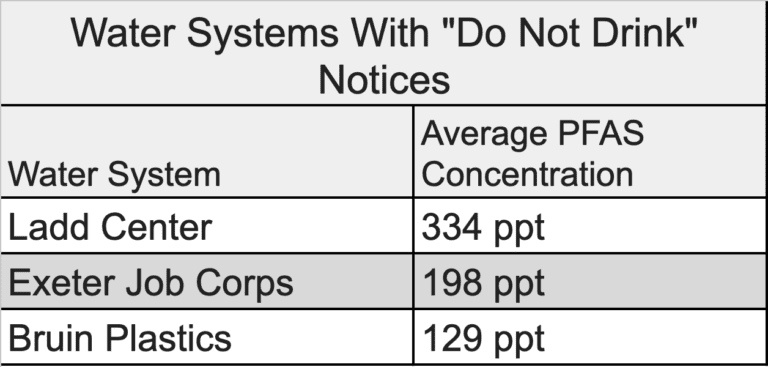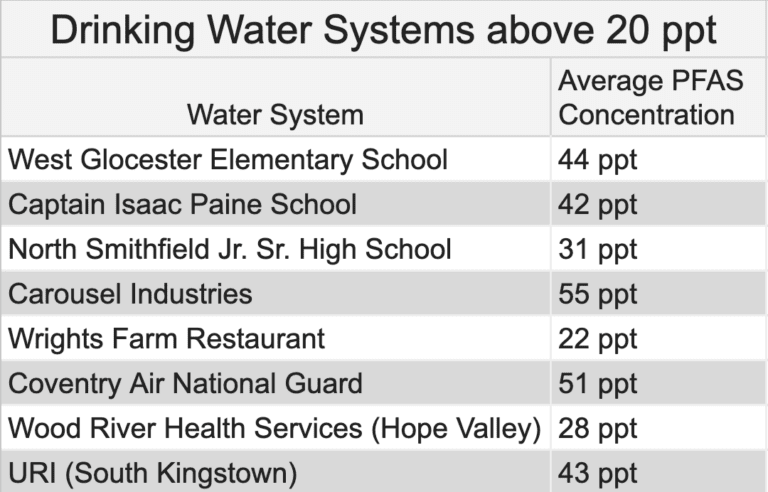New law requires public water systems test for forever chemicals
PFAS found in Exeter, at URI and Wood River
By Colleen Cronin / ecoRI News
staff
 |
| A new law requires public water systems to test for forever chemicals. (Colleen Cronin/ecoRI News graphic) |
The Ladd Center and Exeter Jobs Corps on the former Ladd
School property in Exeter and Bruin Plastics in Burrillville can no longer use
their wells for drinking water after they tested above 70 parts per trillion
(ppt) for per- and polyfluoroalkyl substances (PFAS).
A law that was
passed last year, modified earlier this year, and went into effect July 1,
mandates that public water systems test for the chemicals, which are found in
firefighting foams to food packaging and floor wax and are linked to several cancers, fertility
issues, and developmental delays in children.
Of the 170 public water systems in the state, 164 have
sampled their water, according to RIDOH spokesperson Joseph Wendelken. The
remaining six have until Aug. 10 to report their samplings to be in compliance
with the law.
In addition to requiring new testing, the General
Assembly also created a new interim drinking water standard of 20 ppt for PFAS.
Systems that test above 20 ppt must notify their customers and enter an
agreement with RIDOH within 180 days to remediate the impacted wells, but only
systems that tested above 70 must issue “do not drink” notices to their
customers.
RIDOH and its toxicologist determined that 70 ppt put consumers at a much higher health risk than 20 ppt and decided to set the higher number as the “do not drink standard,” Amy Parmenter, chief administrator for RIDOH’s Center for Drinking Water Quality, told ecoRI News.
“Seventy was previously what the [Environmental Protection Agency] had been using for their health advisory, so there had been some science behind that previously.”
The EPA is currently trying to push for more stringent requirements.
In addition to the Ladd Center, Exeter Jobs Corps, and
Bruin Plastics, eight other water systems tested between 20 and 70 ppt.
The department has posted the test results, which are an average of the first sample
and a confirmatory sample, for the systems that exceeded the standard.
RIDOH wanted to prioritize the systems with higher
results, but will eventually post the results from all the systems, Wendelken
said.
For those systems that have been placed under a no drink
order, water sources are being provided.
According to Lisa Watling from Bruin Plastics’ marketing
department, even before the no drinking water order, employees didn’t drink
from the tap because of concerns about the water, so the order didn’t have a
big impact, she said.
Water will be trucked in for tenants at the Ladd Center
and Exeter Job Corps, according to David Preston, spokesperson for the Quonset
Development Corp., the water system provider for the area.
“Planning for a more permanent solution is well
underway,” he wrote in an email to ecoRI News.
The Exeter Job Corps Center has also been providing water
since the results were announced, a Job Corps spokesperson wrote in an email.
Of those remaining systems that have wells that tested
between 20 and 70 ppt and did not receive a do not drink order, several already
have access to alternative water sources.
 |
| (Colleen Cronin/ecoRI News graphic) |
The well at the Air National Guard Station in Coventry
that tested 84 ppt, then 18 ppt, for an average of 51 ppt, has been shut down
since February, according to Col. Michael Grzybowski, facilities management
officer for the Rhode Island National Guard.
There are three additional wells that tested below the
thresholds and “provide more than enough water,” Grzybowski said. “We have no
current plans to remediate the inactive well,”
The Captain Isaac Paine School in Foster is also no
longer using a well that tested above 20 ppt, although legally it could, and is
instead opting to provide bottled water, according to a public notice it sent
out. The school has also already started the engineering process for a new well
and treatment center and is working with RIDOH and the state Department of
Education to accomplish it.
Two other schools also tested above 20 ppt: West
Glocester Elementary School and North Smithfield Junior and Senior High School.
Neither responded to questions about whether the wells were still in use.
Carousel Industries, a cloud communications service
provider in Exeter, tested at 55 ppt but could also not be reached by phone.
Wright’s Farm Restaurant in Burrillville tested 2 ppt
above the interim standard — the lowest concentration of those wells that exceeded
20 ppt — and has already switched to another well in its system, according to
owner Frank Galleshaw. Galleshaw also said when water was being drawn from the
other well, it was filtered before making its way to customers, and that the
filtered water had tested much lower.
“We are making sure that when folks come to Wright’s
Family Restaurant, they are safe,” he said.
A well at Wood River Health Services in Hopkinton also
tested above 20 ppt but for the time being is still in use, according to CEO
and president Alison Croke. Croke said patients and staff have been notified
and that there are resources besides faucets for drinking water.
A well at the University of Rhode Island that tested at
43 ppt is also still operating. Because URI’s system mixes water from multiple
wells, the actual concentration of PFAS in the water consumed may be much
lower, according to URI spokesperson Anthony LaRoche.
“URI is in the process of implementing a series of
upgrades to its water system that are designed to reduce PFAS to levels well
below the Rhode Island interim drinking water standard,” he said.
Water systems can install a treatment method to remove
PFAS from water or can opt to use a different water source. For example, the
Oakland Water District stopped using its well in
Burrillville after it saw high PFAS results in 2017 and instead had its
customers hook up to Harrisville’s system.
Both moving to a new source (when possible) and
installing a treatment system are expensive, costing potentially millions of dollars,
but RIDOH’s Parmenter said funding is available through the EPA, the Bipartisan
Infrastructure Law passed last year, and the Rhode Island Infrastructure Bank.
“PFAS is treatable,” Wendelken said, which he called a
“silver lining.” But he noted “it’s not a quick fix.”